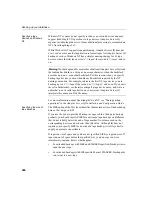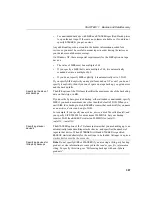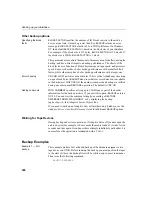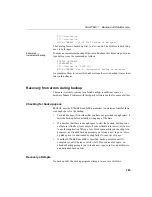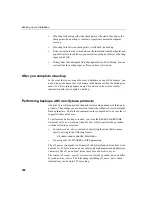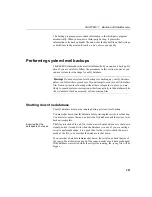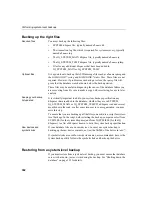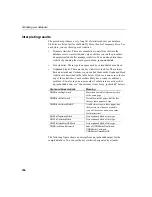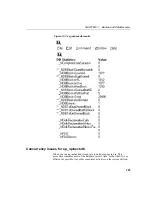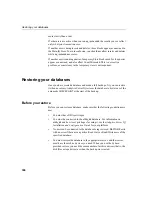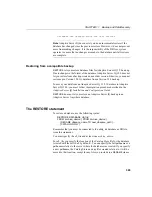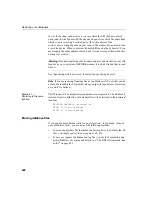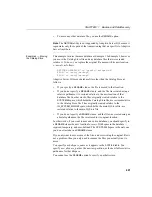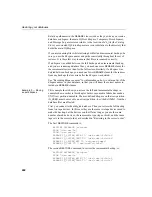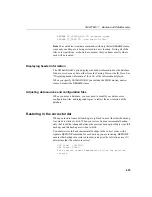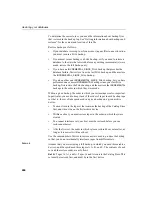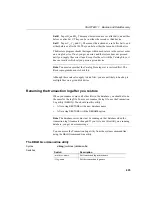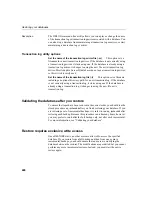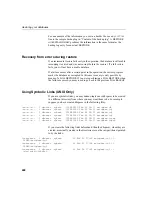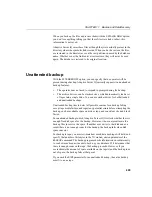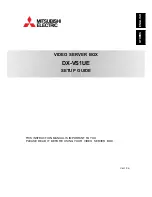
CHAPTER 11 Backup and Data Recovery
397
•
For a full restore, the Catalog Store (by default the .db file) and the
transaction log (by default the .log file) must not exist in the location you
are restoring to. If either of these files exists, you must delete it or move it
to a different directory before doing the full restore.
When a full restore begins, it destroys all old database files and then
recreates them. The requirement that you manually delete the Catalog
Store and transaction log files protects you from doing a full restore
accidentally.
•
For any incremental restore, the Catalog Store (.db) and transaction log
(.log) files must exist. If they exist, but in a different location than the one
you are restoring to, you must follow the procedure described in “Moving
database files”. If either of these files does not exist, you can only do a full
restore.
•
For any incremental restore, the database must not have changed since the
last restore.
Restore requires exclusive access to the database. The default database server
startup option
-gd DBA
guarantees that only the DBA can start a database. To
ensure exclusive access, start the database server with the
-gd DBA
option set,
but do not start the database you are restoring.
RESTORE
automatically starts
the database in such a way that no other users can connect to it.
You must restore an entire backup or set of backups. Restoring individual files
is not supported. However, you can move database files to a new location,
using the
RENAME
clause of the
RESTORE
command.
Restore accommodates dbspace changes
During a set of incremental restores,
RESTORE
creates and drops dbspaces as
needed to match what was done during the period of operation encompassed
by the restores. For example, assume that you make a full backup of a database,
then add a dbspace to that database, and then do an incremental backup after
adding the dbspace. When you restore from these backups,
RESTORE
creates
a file for the new dbspace, at the start of the incremental restore. Similarly, if
you drop a dbspace, it is dropped during the restore, although the actual file is
not removed.
Summary of Contents for Adaptive Server IQ 12.4.2
Page 1: ...Administration and Performance Guide Adaptive Server IQ 12 4 2 ...
Page 16: ...xvi ...
Page 20: ...Related documents xx ...
Page 40: ...Compatibility with earlier versions 20 ...
Page 118: ...Troubleshooting startup shutdown and connections 98 ...
Page 248: ...Importing data by replication 228 ...
Page 306: ...Integrity rules in the system tables 286 ...
Page 334: ...Cursors in transactions 314 ...
Page 396: ...Users and permissions in the system tables 376 ...
Page 438: ...Determining your data backup and recovery strategy 418 ...
Page 484: ...Network performance 464 ...
Page 500: ...System utilities to monitor CPU use 480 ...
Page 514: ...Characteristics of Open Client and jConnect connections 494 ...
Page 536: ...Index 516 ...




